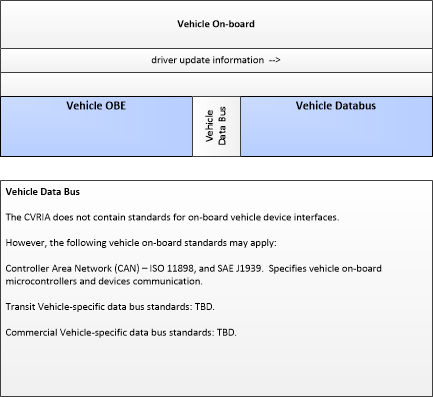Link Type: Vehicle On-Board
Vehicle OBE --> Vehicle Databus:
driver update information
Definitions
driver update information (Information Flow): Information provided to the driver-vehicle interface to inform the driver about current conditions, potential hazards, and the current status of vehicle on-board equipment. The flow includes the information to be presented to the driver and associated metadata that supports processing, prioritization, and presentation by the DVI as visual displays, audible information and warnings, and/or haptic feedback.
Vehicle OBE (Source Physical Object): The Vehicle On-Board Equipment (OBE) provides the vehicle-based processing, storage, and communications functions necessary to support connected vehicle operations. The radio(s) supporting V2V and V2I communications are a key component of the Vehicle OBE. This communication platform is augmented with processing and data storage capability that supports the connected vehicle applications.
In CVRIA, the Vehicle OBE includes the functions and interfaces that support connected vehicle applications for passenger cars, trucks, and motorcycles. Many of these applications (e.g., V2V Safety applications) apply to all vehicle types including personal vehicles, commercial vehicles, emergency vehicles, transit vehicles, and maintenance vehicles. From this perspective, the Vehicle OBE includes the common interfaces and functions that apply to all motorized vehicles.
Vehicle Databus (Destination Physical Object): The 'Vehicle Databus' represents the interface to the vehicle databus (e.g., CAN, LIN, Ethernet/IP, FlexRay, and MOST) that may enable communication between the Vehicle OBE and other vehicle systems to support connected vehicle applications. The vehicle system statuses and/or sensor outputs available on the databus will vary based on the equipment installed on the vehicle and availability on databus. System statuses and sensor outputs may include select vehicle systems and sensors such as accelerometers, yaw rate sensors, and GPS derived location and timing information. In CVRIA, this physical object is used to represent the onboard interactions between the Vehicle OBE and the other systems included in a host vehicle.
Note that the vehicle databus interface is not standardized across all vehicle classes. Also, some Vehicle OBE implementations will not have access to the vehicle databus. See 'Vehicle OBE' for more information.
Included In
This Information Flow is in the following Applications:
- Advanced Automatic Crash Notification Relay
- Advanced Traveler Information Systems
- Blind Spot Warning + Lane Change Warning
- Connected Eco-Driving
- Control Loss Warning
- Cooperative Adaptive Cruise Control
- Curve Speed Warning
- Do Not Pass Warning
- Dynamic Eco-Routing
- Eco-Approach and Departure at Signalized Intersections
- Eco-Cooperative Adaptive Cruise Control
- Eco-Lanes Management
- Eco-Ramp Metering
- Eco-Speed Harmonization
- Eco-Traffic Signal Timing
- Electric Charging Stations Management
- Emergency Electronic Brake Light
- Emergency Vehicle Alert
- Forward Collision Warning
- Incident Scene Work Zone Alerts for Drivers and Workers
- Intelligent Traffic Signal System
- Intermittent Bus Lanes
- Intersection Movement Assist
- Low Emissions Zone Management
- Motorcycle Approaching Indication
- Oversize Vehicle Warning
- Pedestrian in Signalized Crosswalk Warning
- Pedestrian Mobility
- Queue Warning
- Railroad Crossing Violation Warning
- Red Light Violation Warning
- Reduced Speed Zone Warning / Lane Closure
- Restricted Lane Warnings
- Road Weather Motorist Alert and Warning
- Situational Awareness
- Slow Vehicle Warning
- Speed Harmonization
- Spot Weather Impact Warning
- Stationary Vehicle Warning
- Stop Sign Gap Assist
- Stop Sign Violation Warning
- Tailgating Advisory
- Transit Vehicle at Station/Stop Warnings
- Variable Speed Limits for Weather-Responsive Traffic Management
- Vehicle Emergency Response
- Warnings about Hazards in a Work Zone
This Information Flow is in the following Application Objects:
- Vehicle Basic Safety
- Vehicle Electric Charging Assist
- Vehicle Emergency Notification I/F
- Vehicle Environmental Monitoring
- Vehicle Gap Assist
- Vehicle Interactive Traveler Information
- Vehicle Intersection Warning
- Vehicle Mayday Notification
- Vehicle Payment Service
- Vehicle Queue Warning
- Vehicle Rail Crossing Warning
- Vehicle Restricted Lanes Application
- Vehicle Roadside Information Reception
- Vehicle Speed Management Assist
- Vehicle Trip Planning and Route Guidance
Communication Diagrams
The communication diagram(s) can be viewed in SVG or PNG format and the current format is SVG. Switch to PNG format.
Characteristics
Architectural:
| None defined |
Security
This information flow triple is in the following applications with the following security levels.
| Information Flow Security | |||||
|---|---|---|---|---|---|
| Application | Confidentiality | Integrity | Availability | ||
| Basis | Basis | Basis | |||
| Incident Scene Work Zone Alerts for Drivers and Workers | Low | Moderate | Moderate | ||
| This warning would be created using data that was shared with everyone. | This information is important for drivers to receive. However, if they do not receive it, there should be other indicators about the incident that prevent a collision. | This system should be able to operate properly if most messages are received. | |||
| Pedestrian in Signalized Crosswalk Warning | Low | Moderate | Moderate | ||
| All of this information is information that will be sent via broadcast, received via broadcast, or could be derived by observing the vehicle. | In this instance, the data displayed to the driver is based on all of the previous inputs to the application. If the integrity of this information flow is not held to the same standard, it invalids the rest of the assessments. | As with integrity, the requirement here is based off of all of the previous information flows. This should be MEDIUM to ensure that the notification reaches the driver correctly. However, there are other indicators of pedestrians in the crosswalk, and the driver should not be 100% reliant on the notifications before proceeding. Additionally, there should some form of notification to the driver when messages are unable to be presented correctly, informing them to have their vehicle serviced | |||
